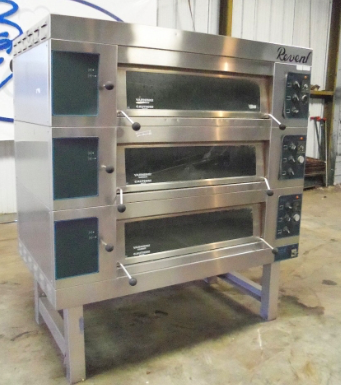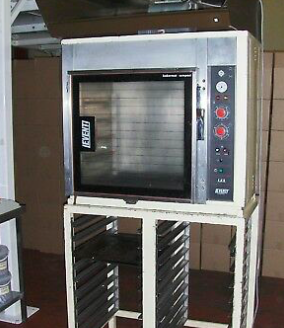Trying to find a low-cost option for your next commercial bakery oven? We have a large inventory of affordable equipment options for your bakery or restaurant. Check this page frequently as new inventory is added each week. Browse our used restaurant equipment section to find even more deals.
[display_listings l_type=”99″]
Introduction to Bakery Ovens

If you’re like most commercial bakers, you already know how critical your choice of oven is in producing consistently excellent rolls, loaves, or baguettes. Whether you’re opening a new bakery, or simply shopping for new equipment to replace the aging bucket of bolts that’s just not working right anymore, choosing the right bakery oven can feel like a daunting process.
The used commercial bakery oven that’s right for you and your business probably depends on a balance of four things: The type of items you will be baking, the volume of baked goods you need to produce each day, the limitations or your baking environment (either physical, or thanks to the fire code), as well as how much of your equipment budget you can afford to spend on a single purchase.
We’ve rounded up a few of the considerations every equipment buyer must face, when choosing a used commercial baking oven. Here are a few things to consider:
What Types of Used Commercial Baking Ovens Are There?

In the world of used commercial baking ovens, convection ovens are probably the most common. Convection ovens can quickly and evenly bake a wide variety of different items, from loaves of bread and rolls to baked goods like pies and cakes. Convection ovens increase efficiency and decrease cooking time by circulating the warm air inside the oven as it cooks, blowing the air across the surface of the food using recirculating fans.
This results in even browning, and consistent, predictable products, each and every time. Some higher-end convection ovens also include steam injection and other specialized special features, depending on what you plan to be baking. In addition to being the most common, convection ovens also tend to be the least expensive.
Rustic or artisan-style bread bakers are leaning more and more toward deck ovens, which are enormous units with vertically small cooking areas, and wide stone or cast iron decks for heating. Breads baked in deck-style ovens tend to have crispier crusts, with soft, pliable insides, making them a good choice for sandwich rolls, sourdough loaves, or baguettes.
Unfortunately, deck ovens tend to swallow up a lot of real estate in a commercial kitchen when compared to a convection oven. Compared to convection ovens, however, deck ovens are generally pretty low-tech appliances, ensuring that when breakdowns occur, they are infrequent and typically inexpensive to repair.
Imagine a walk-in refrigerator with vertical rolling racks, or a freestanding proofing box that you can roll racks right into; that’s pretty much the concept behind a roll-in oven. Some higher-end models will even rotate the pans in the rack for more even browning and more consistent results. The reduced time spent handling product can often translate into labor savings in a busy commercial bakery.
A revolving or carousel oven is very similar in style to a rotisserie oven; it features large trays that get loaded with dough, which then rotate through the oven chamber. This feature gives these ovens a very high capacity and production rate, but are also expensive to operate and maintain, with a high initial sticker price, to match.
Before considering this type of used commercial bakery oven, make sure that your volume demands make this type of oven necessary for your business.
Electric Bakery Ovens vs. Natural Gas or Propane

Choosing a heating technology is an important next step in evaluating their needs for a used commercial bakery oven. Ovens typically come in one of two flavors: Electric, or gas (either natural gas or bottled propane). The type of oven you buy is based on a few different factors: Personal preference, the availability of gas and electric connections, how much “firepower” you need in your bakery oven, and your budget are all important factors to consider when choosing between electric and gas.
Electric bakery ovens are usually cheaper, easier to install, and don’t require a gas line for operation. These ovens often have simpler code requirements, and may not even require fire suppression or exhaust in some locations. However, electric ovens have a reputation for being slow to heat up, as well as less capable in the higher temperature ranges.
Gas-powered bakery ovens offer precise, consistent temperature control, with typically shorter warm-up times. In addition, natural gas and liquid propane tend to heat more efficiently, which usually translates to reduced cost to run the oven Some of these savings may be offset by the relatively high cost to install in kitchens without existing gas lines, however.
How Do I Evaluate a Used Commercial Bakery Oven?

Like most of us, you’re probably looking for ways to cut costs in your equipment-purchasing budget. Fortunately, unlike many types of commercial appliances, used commercial bakery ovens are a safe place to try and save a few dollars.
Bakery ovens don’t often give up much in terms of performance versus new ovens, and often come at a significant savings. While a used commercial bakery oven may not have some of the features of brand-spanking-new, top-of-the-line ovens, such as digital controls or increased energy efficiency, used ovens can usually meet the same goal of “turning dough into bread” as a new oven.
The biggest potential risk to consider when buying a used commercial bakery oven is that of increased down time due to equipment failure, or a used oven that requires maintenance sooner than one that’s brand new. Of course, newer ovens tend to have more bells-and-whistles, which may make them prone to breakdown, sooner.
When evaluating a used commercial oven for potential purchase, we recommend ovens which contain fewer of these newfangled features, rather than the latest computer-controlled all-digital behemoths.
Look for gas-fired ovens (if your kitchen setup will provide for gas appliances), since these tend to have a simpler design, be less prone to breakdown, generally heat more quickly and are capable of maintaining higher heat, and less costly to repair than their electric counterparts.
First, inspect the oven door itself. Be on the lookout for cracked (or completely missing!) seals, which will dramatically affect the performance of your oven. Invest in a good infrared thermometer, which will allow you to pinpoint both “cold” and “hot” spots within the baking environment.
An infrared thermometer will also help you to verify that that the cooking temperature inside the oven matches what’s on the dial or digital display; we’ve seen ovens where the temperature can be off by as much as fifty degrees, which can cause a lot of unwanted surprises in a busy bakery kitchen.
If the temperature inside the oven doesn’t match the temperature setting, don’t freak out yet. The temperature readout on the display or knob can usually be calibrated inside the oven itself, so if the temperatures don’t match, check that before deciding whether or not to pass on the sale. Finally, when it comes to aesthetics, remember: An oven that’s been in service since the turn of the century and looks like a mess, but which provides quick, consistent, even heat is preferable to a shiny, cosmetically perfect oven with all of the bells and whistles, but which can’t hold a temperature.
If something doesn’t seem to be working right with the used commercial bakery oven you are considering, or if there are known problems with the oven, contact the manufacturer prior to closing the deal to check on the replacement price of parts that are prone to failure.
You may be able to negotiate an amazing price on an oven that the current owner thinks of as “broken,” if you’re willing to have it repaired yourself, often potentially inexpensively.
